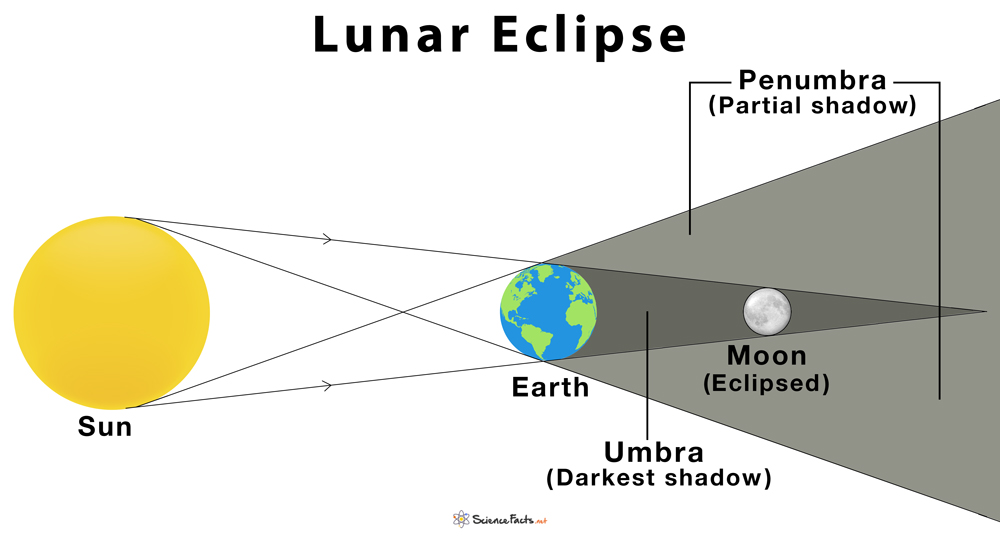

PICTURE OF LUNAR ECLIPSE DIAGRAM FULL
Gain more understanding of lunar eclipses, learn about NASA’s observations of eclipses, and inspire young stargazers with activities and information.įinally, if you want to know what else is happening as you watch the skies in November, check out Jet Propulsion Laboratory’s latest “What’s Up” video:Ī total lunar eclipse brings some magic to the morning sky on November 8th, and the Leonid meteors peak after midnight on November 18th, with some glare from a 35% full moon. Sterling says a fun activity for those who stargaze with family or friends is to discuss who notices the reddish hue of totality first and how it progresses throughout the eclipse. While the lunar eclipse can be observed with the unaided eye, a pair of binoculars or a telescope can enhance the view. No special eye protection is needed for viewing a lunar eclipse, unlike solar eclipses (which occur during the daytime). As NASA works to establish a permanent human presence on the Moon through the Artemis program, it’s fascinating to consider how Earthlings will experience astronomical events away from their home planet. The degree of redness of a fully eclipsed Moon can be influenced by atmospheric conditions resulting from volcanic eruptions, fires, and dust storms.īut what does Earth look like from the Moon’s perspective during a lunar eclipse? According to Mitzi Adams, astrophysicist at Marshall, astronauts on the Moon during a total lunar eclipse would see a red ring around a silhouetted Earth. Some of that red light is refracted, or bent, as it passes through Earth’s atmosphere and ends up shining on the Moon with a ghostly red light. Light from the Sun collides into the gases of Earth’s atmosphere and because of its shorter wavelength, blue light is filtered out, but red light is not easily scattered because of its longer wavelength. Rayleigh scattering is also the reason for red sunrises and sunsets. Credit: NASA’s Scientific Visualization Studio The map is centered on 168★7’W, the sublunar longitude at mid-eclipse. Contours mark the edge of the visibility region at eclipse contact times. The scattering is a phenomenon called Rayleigh scattering – named after the 19th-century British Physicist Lord Rayleigh.Ī map showing where the November 8, 2022, lunar eclipse is visible. The red color occurs because of the refraction, filtering, and scattering of light by Earth’s atmosphere. Those in the eastern part of the United States will miss most or all of the last partial phase because the Moon will set during totality or shortly after totality ends.Īnother feature of a total lunar eclipse is the Moon’s red hue during totality. Then, the partial phase will resume, lasting until 6:49 a.m. CST, with totality beginning at 4:16 a.m. Vector layered paper cut style solar eclipse diagram. The partial eclipse will begin at 3:09 a.m. PIXTA offers high-quality Lunar eclipse stock photos, illustrations and vectors at affordable. Credit: NASA/Michoud Assembly Facilityįor North America, the action will start in the early hours of the morning on November 8. The 97% eclipse clocked in at 3 hours, 28 minutes, and 24 seconds, making it the longest partial lunar eclipse in 580 years. It will be true of any planetary body with little or no atmosphere and an irregular cratered surface (e.g., Mercury) when viewed opposite the Sun.A nearly total eclipse of November’s full “Beaver Moon” captured over the city of New Orleans before dawn on November 19, 2021. This is similar to the effect of velvet fabric over a convex curved surface which to an observer will appear darkest at the center of the curve. This is because as viewed from the Earth, the brightness of a lunar limb is generally greater than that of the rest of the surface due to reflections from the many surface irregularities within the limb: sunlight striking these irregularities is always reflected back in greater quantities than that striking more central parts, and is why the edges of full moons generally appear brighter than the rest of the lunar surface. Later, as the moon’s opposite limb is struck by sunlight, the overall disk will again become obscured. The moment the moon enters a complete eclipse, the entire surface will become more or less uniformly bright. Just prior to complete entry, the brightness of the lunar limb– the curved edge of the moon still being hit by direct sunlight– will cause the rest of the moon to appear comparatively dim. This occurs when the moon falls entirely within the earth’s umbra.


 0 kommentar(er)
0 kommentar(er)
